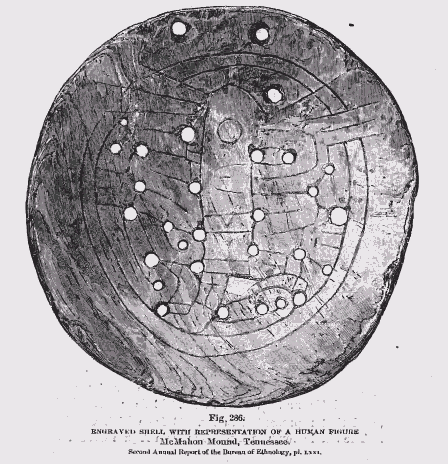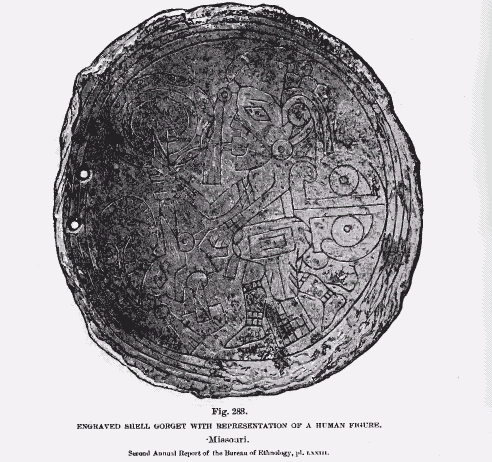|
The Swastika
Forms Allied to the Swastika
Page 104
which was imported and which
indigenous, would be to decide the entire question of migration, and if
done off-hand, would be presumptuous. To make a satisfactory decision
will require a marshaling and consideration of evidence which belongs
to
 the future. The specimens
shown in figs. 280, 281,
282, 283, 284
and 285 are from Tennessee and Virginia. They are all masks, bearing
representations of the human face. The first two are from the McMahon
mound, Tennessee; that in fig.
282 from Brakebill mound, Tennessee, and that represented in
fig. 283 from Lick Creek mound, Tennessee. The shell shown in fig.
284 is from Aquia Creek, Virginia, and that in fig.
285 is from a mound in Ely County, Va. The workmanship on these has
the future. The specimens
shown in figs. 280, 281,
282, 283, 284
and 285 are from Tennessee and Virginia. They are all masks, bearing
representations of the human face. The first two are from the McMahon
mound, Tennessee; that in fig.
282 from Brakebill mound, Tennessee, and that represented in
fig. 283 from Lick Creek mound, Tennessee. The shell shown in fig.
284 is from Aquia Creek, Virginia, and that in fig.
285 is from a mound in Ely County, Va. The workmanship on these has
 no resemblance to that on
the Buddha figure (pl. 10), nor does its style
compare in any manner therewith.
no resemblance to that on
the Buddha figure (pl. 10), nor does its style
compare in any manner therewith.
On the contrary, figs. 286 and 288,
representing sketches (unfinished) of the human figure, from mounds in
Tennessee and Missouri, have some resemblance in style of work, though
not in design, to that of the Buddha and Swastika figures. The first step
in execution, after the drawing by incised lines, seems to have been
 to drill holes through the
shell at each corner and intersection. The work on the specimen shown
in fig. 286 has progressed further than that on the specimens shown in
figs. 287 and 288. It has twenty-eight holes drilled, all at corners or
intersections. This is similar to the procedure in the Buddha statue (pl.
10). In fig. 287 the holes have not been drilled, but each member
of the figure has been marked out and indicated by dots in the center,
and circles or half circles incised around them in precisely the same
manner as in both Swastikas (figs.
237 and 238), while fig.
288 continues the resemblance in style of drawing. It has the same peculiar
to drill holes through the
shell at each corner and intersection. The work on the specimen shown
in fig. 286 has progressed further than that on the specimens shown in
figs. 287 and 288. It has twenty-eight holes drilled, all at corners or
intersections. This is similar to the procedure in the Buddha statue (pl.
10). In fig. 287 the holes have not been drilled, but each member
of the figure has been marked out and indicated by dots in the center,
and circles or half circles incised around them in precisely the same
manner as in both Swastikas (figs.
237 and 238), while fig.
288 continues the resemblance in style of drawing. It has the same peculiar
<< Previous Page
Next
Page >>
© 2004-2007 Northvegr.
Most of the material on this site is in the public domain. However, many people have worked very hard to bring these texts to you so if you do use the work, we would appreciate it if you could give credit to both the Northvegr site and to the individuals who worked to bring you these texts. A small number of texts are copyrighted and cannot be used without the author's permission. Any text that is copyrighted will have a clear notation of such on the main index page for that text. Inquiries
can be sent to info@northvegr.org.
Northvegr™ and the Northvegr symbol are trademarks and service marks
of the Northvegr Foundation.
|
> Northvegr™ Foundation
>> About Northvegr Foundation
>> What's New
>> Contact Info
>> Link to Us
>> E-mail Updates
>> Links
>> Mailing Lists
>> Statement of Purpose
>> Socio-Political Stance
>> Donate
> The Vík - Online Store
>> More Norse Merchandise
> Advertise With Us
> Heithni
>> Books & Articles
>> Trúlög
>> Sögumál
>>
Heithinn Date Calculator
>> Recommended Reading
>>
The 30 Northern Virtues
> Recommended Heithinn Faith Organizations
>> Alfaleith.org
> NESP
>> Transcribe Texts
>> Translate Texts
>> HTML Coding
>> PDF Construction
> N. European Studies
>> Texts
>> Texts in PDF Format
>> NESP Reviews
>> Germanic Sources
>> Roman Scandinavia
>> Maps
> Language Resources
>> Zoëga Old Icelandic Dict.
>> Cleasby-Vigfusson Dictionary
>> Sweet's Old Icelandic Primer
>> Old Icelandic Grammar
>> Holy Language Lexicon
>> Old English Lexicon
>> Gothic Grammar Project
>> Old English Project
>> Language Resources
> Northern Family
>> Northern Fairy Tales
>> Norse-ery Rhymes
>>
Children's Books/Links
>> Tafl
>> Northern Recipes
>> Kubb
> Other Sections
>> The Holy Fylfot
>> Tradition Roots

Please Visit Our Sponsors
- Référencement
- Alfaleith.org - Heithni, Viðartrú
- Odin's Journey
- Baman - Iceland/Aboriginal Australia
- Biker's Booty
- Création site Internet Paris
- Pagan T-shirts
- Appartements
- Chalets au Québec
- Logo Designers
- Web Design
- Appartements Montreal
- Espace Bureau Montreal
- London Tours
- Spanish Property Legal Advice
- Multi Pret Hypotheque
- Company Logo Design
- Wiccan T-shirts
- Art Gallery, Painting artists
- free logo design reviews
- Heathen, Heathenism, Norse Pagan
- Logo design by LogoBee
- Pagan Shirts
- Norse Pagan Religion
- Triumph, BSA, Norton, Euro Motorcycles - Accessories
- Logo Maker
- Logo Design - Business Logos, Inc.
- Logo Design - Logo Maker
- Create A Website
- Wiccan Shirts
- Mortgages
- Multi-Prêts Hypothèques
- Viking T-shirts
- Hewlett Packard Ink Cartridges
- Indian Recipes
- Logo Design London
- Logo Design
- Logo Design UK
- Subvention et financement PME
- Heathen T-shirts
- Medical Alert, Emergency response
- orlando hotels
- Slot Machines for Vikings
- Norse Pagan Clothing and Merchandise
- New Homes
- Branding Irons
- Bachelor Degree Online
- Online Degree
- College Degree
- Heathen, Viking and Norse Texts
- Création site Internet
- Montreal Web Design
- Free Dish Network Satellite TV
- Discount ink cartridge & laser cartridge
- DUI Lawyers & DWI Attorneys
- Promotional Products
- Ready-Made Company Logos
- Canadian Art Dealer
- Best CD Rates
- Laser Toner Cartridge
- Logotyper & Grafiska Profilprogram
- Banner Design
- Custom Logo Design
Web site design and coding by Golden Boar Creations
|
|





